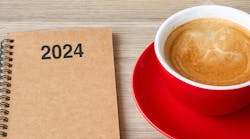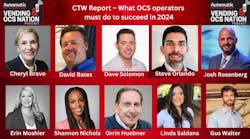Coffee, tea and water solutions: 3 compelling lessons for OCS operators
One benefit of NAMA’s annual Coffee, Tea and Water Show (CTW) is the willingness of operators to help one another by sharing trends and ideas that have an impact on the industry, through conversations and the educational seminars. The 2023 show, held November 6-7 in Indianapolis, was no exception, and there was plenty of valuable takeaways. Here are three compelling lessons from the show.
Lesson #1: Sustainability efforts can engage your own workforce, clients and customers – and they don’t need to be complicated.
In the CTW education session, “Approaching Sustainability,” Rich “Raz” Razgaitis, CEO and co-founder of FloWater, made a strong case for operators to implement a strategic sustainability program. “It will help the environment and your bottom-line,” he said.
Razgaitis said that customers, employees and investors are increasingly demanding strong ESG (environmental, social and governance) policies. “It’s time to consider not just how to create sustainability plans that have a meaningful impact but also how those plans can be a financial net positive for your business,” he added.
Razgaitis outlined how a business can benefit from sustainable practices:
- Reducing the raw materials used to manufacture your products will lower your costs.
- Sustainability can become a crucial marketing differentiator from competitors with similar products or services.
- Build a strong workforce and improve employee retention. 65% of employees surveyed by Unilay said they would be more likely to work for a company with sustainable practices.
He also explored strategies on how to sell sustainability:
- See sustainability as an amenity, not a penalty. It’s a benefit for your customers and employees.
- Don’t sell on sustainability; sell on innovation.
- Don’t sell FAB (features, advantages and benefits). Instead, use meaningful outcomes and data.
- Create a fantastic anchor product, and then leverage the halo effect around it.
Lesson #2: Innovation creates opportunity for operators.
In an interview at CTW, Josh Rosenberg, president and chief revenue officer, Automated Retail Technologies, was passionate about taking steps to keep employees in the workplace, consuming products that are being sold by operators.
“We have to continue to look at the coffee service landscape. The opportunity for us is to offer innovation,” said Rosenberg. “We know they will buy coffee and tea from us, but the consumer is still more likely to go off site to get their espresso and their specialty coffee drink. In this room, we have the equipment that will allow you to bring those products to their door. There is so much value prop to having the high-end coffee amenity on site.”
Rosenberg added that the OCS industry’s solution is a perfect fit for offices that don’t want delivery people coming into the office and don’t want their employees going off site.
Creating the right space
Steve Orlando, co-founder of Fixturelite, said operators need to focus on the breakroom as part of the innovation concept. “We need to make the OCS amenity an experience for our customers, with quality and presentation,” said Orlando. “That goes hand-in-hand with the innovative solutions we need to offer. If you want employees to stay in the workplace enjoying your products, you need to create a space that employees want to spend time in.”
Bean-to-cup brewers are leading the way when it comes to OCS innovation, generating both customer satisfaction and operator revenue. In the CTW education session, “Demystifying and Maximizing Bean-to-Cup ROI,” John Stavros, territory manager for Evoca Group North America, reminded operators that bean-to-cup is an excellent opportunity to create strong customer relationships.
“In the right accounts, bean-to-cup brewers have the highest potential to match client needs,” Stavros said. “From the modular nature of the equipment to the ever-changing interface and experience, providing coffee from whole bean allows operators to control the taste and branding of their services while getting the most opportunity to control their costs and formulate a strategy for success.”
Lesson #3: Operators need to be proactive and capitalize on the wide range of opportunities that exist.
While innovation is critical, it takes a proactive approach by operators to capitalize on the opportunities in the workplace that are often overlooked. In the CTW education session, “Cold Brew: Hot Opportunities,” Bill Kirchoff, food service manager at Distant Lands Coffee, and Mike Hoeft, VP of sales at Bunn, talked about cold brew coffee – an opportunity for revenue that many operators shy away from.
They pointed to the fact that cold brew coffee is one of the hottest trends in the U.S. coffee market. According to a 2022 report, the total size of this market stood at around $166 million in 2017, and by 2025, this figure is forecast by Statista to increase to around $944 million and could go as high as over $1.37 billion, according to research firm Technavio.
In their presentation, they cited reasons why cold brew is easy to sell. It increases productivity (keeping employees in house), it is viewed as a positive amenity so it attracts and retains talent, it is often seen as a healthier beverage than others, and many consumers like the taste.
Don’t overlook obvious revenue
In a convention floor interview, industry consultant Orrin Huebner said cold brew is just one of many revenue opportunities that operators need to embrace. He said that operators especially need to look at the water opportunity, with many quality products available, like the sleek point-of-use equipment from Borg & Overström and others. Huebner also believes that operators are selling themselves short when it comes to price increases and not charging enough or anything at all to perform certain services.
“Don’t overlook the obvious revenue that is available,” Huebner said. “Nobody walks into your house today to perform a service for less than $80-$125. Yet, operators are walking into locations and changing the filters for free. We should be looking at quarterly filter changes and telling the story to the customer that we are here for you, and part of that is about good water and clean equipment, because if you do not have high-quality water and clean water lines, it leads to potential health concerns. Ice machines should be flushed twice a year for a fee. Kombucha should be flushed out every month – there is bacteria buildup. We just aren’t doing it enough. We can charge $85 to flush a line. Your cost is minimal, and if you schedule it correctly, you can change filters, service an ice machine and flush lines – that means three services in one trip, which really cuts your employee costs. It all falls to the bottom-line. It’s incremental profit at that point.”
Huebner also said that operators are too focused on adding new accounts instead of looking at their existing accounts. “There are so many options from water machines to ice machines,” he said. “The best thing operators can do today is look at their accounts and ask, what add-ons are there? You just have to look for them and embrace them. If you can pay off your water and ice machines in 12 to 14 months, after that, it becomes an annuity that just keeps paying off over and over, especially when service fees become part of the equation.”

Bob Tullio
Bob Tullio is a content specialist, speaker, sales trainer, consultant and contributing editor of Automatic Merchandiser and VendingMarketWatch.com. He advises entrepreneurs on how to build a successful business from the ground up. He specializes in helping suppliers connect with operators in the convenience services industry — coffee service, vending, micro markets and pantry service specifically. He can be reached at 818-261-1758 and [email protected]. Tullio welcomes your feedback.
Subscribe to Automatic Merchandiser’s new podcast, Vending & OCS Nation, which Tullio hosts. Each episode is designed to make your business more profitable.









